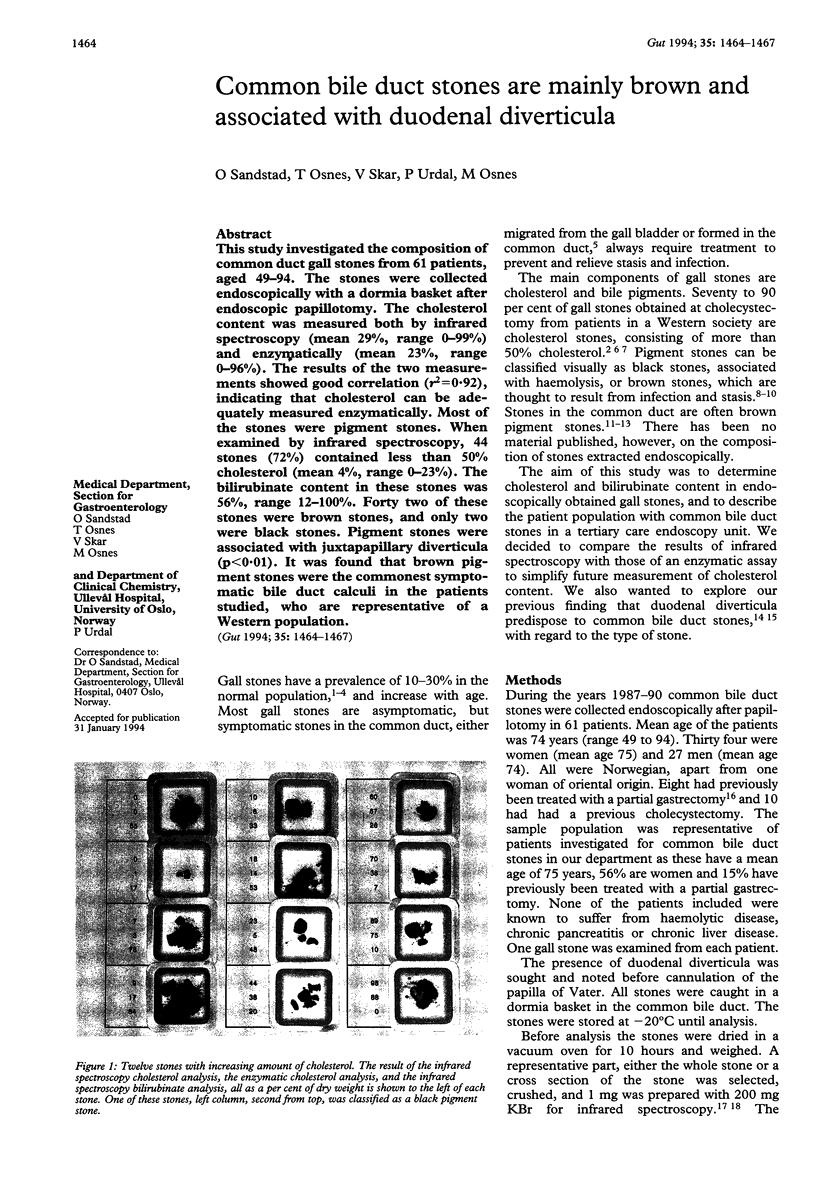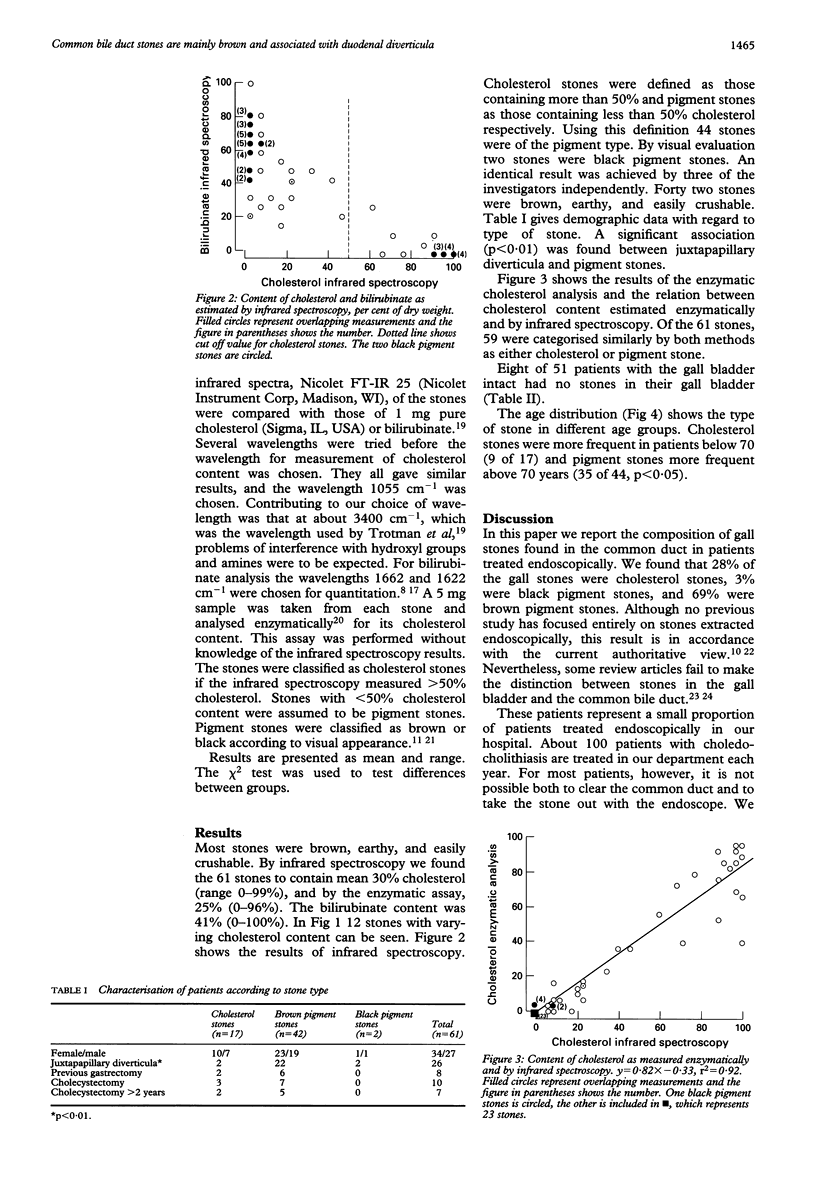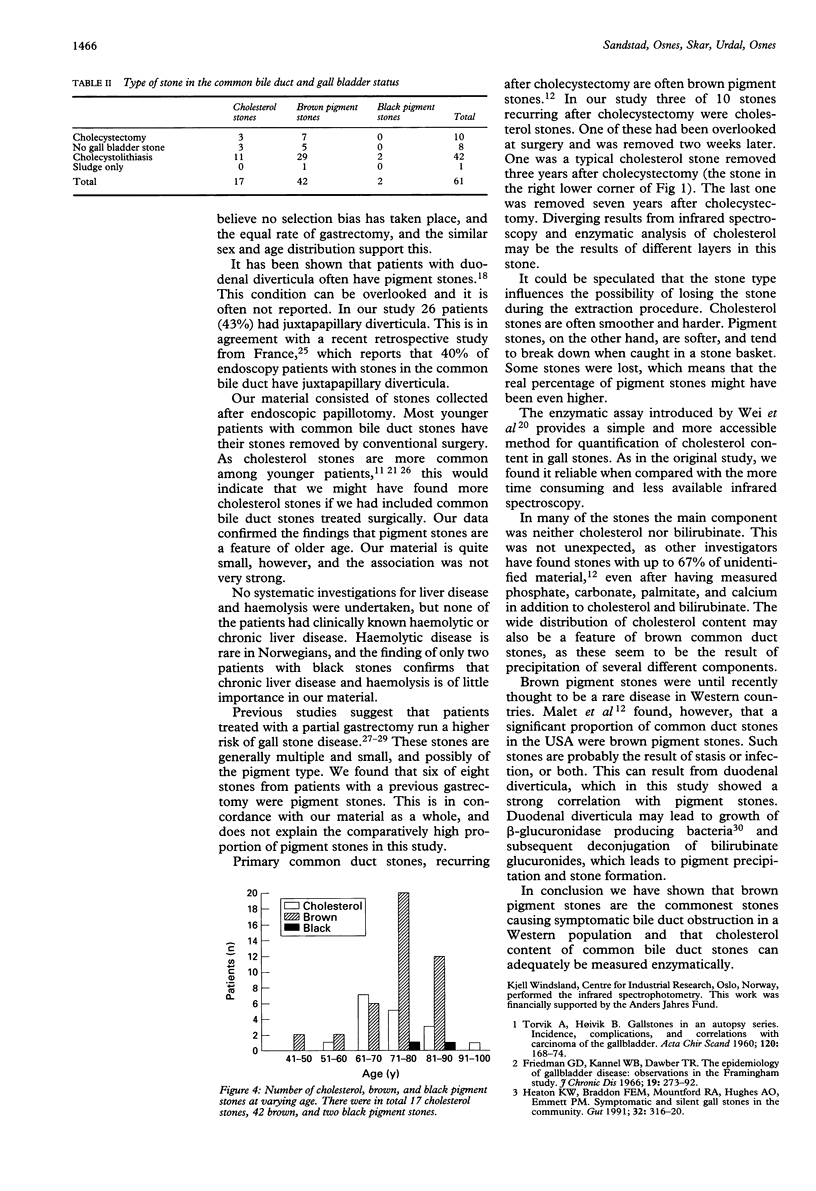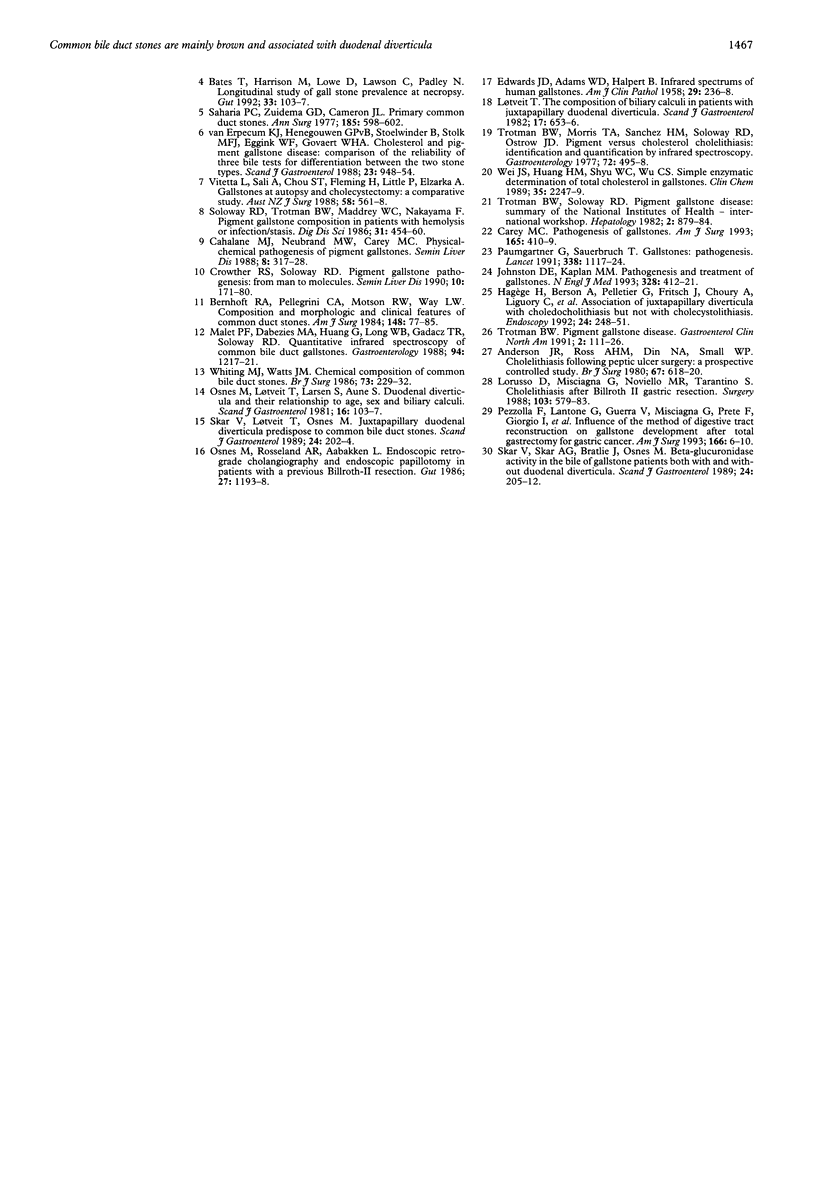Abstract
This study investigated the composition of common duct gall stones from 61 patients, aged 49-94. The stones were collected endoscopically with a dormia basket after endoscopic papillotomy. The cholesterol content was measured both by infrared spectroscopy (mean 29%, range 0-99%) and enzymatically (mean 23%, range 0-96%). The results of the two measurements showed good correlation (r2 = 0.92), indicating that cholesterol can be adequately measured enzymatically. Most of the stones were pigment stones. When examined by infrared spectroscopy, 44 stones (72%) contained less than 50% cholesterol (mean 4%, range 0-23%). The bilirubinate content in these stones was 56%, range 12-100%. Forty two of these stones were brown stones, and only two were black stones. Pigment stones were associated with juxtapapillary diverticula (p < 0.01). It was found that brown pigment stones were the commonest symptomatic bile duct calculi in the patients studied, who are representative of a Western population.
Full text
PDF



Images in this article
Selected References
These references are in PubMed. This may not be the complete list of references from this article.
- Anderson J. R., Ross A. H., Din N. A., Small W. P. Cholelithiasis following peptic ulcer surgery: a prospective controlled study. Br J Surg. 1980 Sep;67(9):618–620. doi: 10.1002/bjs.1800670904. [DOI] [PubMed] [Google Scholar]
- Bates T., Harrison M., Lowe D., Lawson C., Padley N. Longitudinal study of gall stone prevalence at necropsy. Gut. 1992 Jan;33(1):103–107. doi: 10.1136/gut.33.1.103. [DOI] [PMC free article] [PubMed] [Google Scholar]
- Bernhoft R. A., Pellegrini C. A., Motson R. W., Way L. W. Composition and morphologic and clinical features of common duct stones. Am J Surg. 1984 Jul;148(1):77–85. doi: 10.1016/0002-9610(84)90292-7. [DOI] [PubMed] [Google Scholar]
- Cahalane M. J., Neubrand M. W., Carey M. C. Physical-chemical pathogenesis of pigment gallstones. Semin Liver Dis. 1988 Nov;8(4):317–328. doi: 10.1055/s-2008-1040553. [DOI] [PubMed] [Google Scholar]
- Carey M. C. Pathogenesis of gallstones. Am J Surg. 1993 Apr;165(4):410–419. doi: 10.1016/s0002-9610(05)80932-8. [DOI] [PubMed] [Google Scholar]
- Crowther R. S., Soloway R. D. Pigment gallstone pathogenesis: from man to molecules. Semin Liver Dis. 1990 Aug;10(3):171–180. doi: 10.1055/s-2008-1040471. [DOI] [PubMed] [Google Scholar]
- EDWARDS J. D., Jr, ADAMS W. D., HALPERT B. Infrared spectrums of human gallstones. Am J Clin Pathol. 1958 Mar;29(3):236–238. doi: 10.1093/ajcp/29.3.236. [DOI] [PubMed] [Google Scholar]
- Friedman G. D., Kannel W. B., Dawber T. R. The epidemiology of gallbladder disease: observations in the Framingham Study. J Chronic Dis. 1966 Mar;19(3):273–292. doi: 10.1016/0021-9681(66)90132-9. [DOI] [PubMed] [Google Scholar]
- Hagège H., Berson A., Pelletier G., Fritsch J., Choury A., Liguory C., Etienne J. P. Association of juxtapapillary diverticula with choledocholithiasis but not with cholecystolithiasis. Endoscopy. 1992 May;24(4):248–251. doi: 10.1055/s-2007-1010476. [DOI] [PubMed] [Google Scholar]
- Heaton K. W., Braddon F. E., Mountford R. A., Hughes A. O., Emmett P. M. Symptomatic and silent gall stones in the community. Gut. 1991 Mar;32(3):316–320. doi: 10.1136/gut.32.3.316. [DOI] [PMC free article] [PubMed] [Google Scholar]
- Johnston D. E., Kaplan M. M. Pathogenesis and treatment of gallstones. N Engl J Med. 1993 Feb 11;328(6):412–421. doi: 10.1056/NEJM199302113280608. [DOI] [PubMed] [Google Scholar]
- Lorusso D., Misciagna G., Noviello M. R., Tarantino S. Cholelithiasis after Billroth II gastric resection. Surgery. 1988 May;103(5):579–583. [PubMed] [Google Scholar]
- Løtveit T. The composition of biliary calculi in patients with juxtapapillary duodenal diverticula. Scand J Gastroenterol. 1982 Aug;17(5):653–656. doi: 10.3109/00365528209181074. [DOI] [PubMed] [Google Scholar]
- Malet P. F., Dabezies M. A., Huang G. H., Long W. B., Gadacz T. R., Soloway R. D. Quantitative infrared spectroscopy of common bile duct gallstones. Gastroenterology. 1988 May;94(5 Pt 1):1217–1221. doi: 10.1016/0016-5085(88)90015-7. [DOI] [PubMed] [Google Scholar]
- Osnes M., Rosseland A. R., Aabakken L. Endoscopic retrograde cholangiography and endoscopic papillotomy in patients with a previous Billroth-II resection. Gut. 1986 Oct;27(10):1193–1198. doi: 10.1136/gut.27.10.1193. [DOI] [PMC free article] [PubMed] [Google Scholar]
- Paumgartner G., Sauerbruch T. Gallstones: pathogenesis. Lancet. 1991 Nov 2;338(8775):1117–1121. doi: 10.1016/0140-6736(91)91972-w. [DOI] [PubMed] [Google Scholar]
- Pezzolla F., Lantone G., Guerra V., Misciagna G., Prete F., Giorgio I., Lorusso D. Influence of the method of digestive tract reconstruction on gallstone development after total gastrectomy for gastric cancer. Am J Surg. 1993 Jul;166(1):6–10. doi: 10.1016/s0002-9610(05)80573-2. [DOI] [PubMed] [Google Scholar]
- Saharia P. C., Zuidema G. D., Cameron J. L. Primary common duct stones. Ann Surg. 1977 May;185(5):598–604. doi: 10.1097/00000658-197705000-00013. [DOI] [PMC free article] [PubMed] [Google Scholar]
- Skar V., Løtveit T., Osnes M. Juxtapapillary duodenal diverticula predispose to common bile duct stones. Scand J Gastroenterol. 1989 Mar;24(2):202–204. doi: 10.3109/00365528909093037. [DOI] [PubMed] [Google Scholar]
- Skar V., Skar A. G., Bratlie J., Osnes M. Beta-glucuronidase activity in the bile of gallstone patients both with and without duodenal diverticula. Scand J Gastroenterol. 1989 Mar;24(2):205–212. doi: 10.3109/00365528909093038. [DOI] [PubMed] [Google Scholar]
- Soloway R. D., Trotman B. W., Maddrey W. C., Nakayama F. Pigment gallstone composition in patients with hemolysis or infection/stasis. Dig Dis Sci. 1986 May;31(5):454–460. doi: 10.1007/BF01320307. [DOI] [PubMed] [Google Scholar]
- Trotman B. W., Morris T. A., 3rd, Sanchez H. M., Soloway R. D., Ostrow J. D. Pigment versus cholesterol cholelithiasis: identification and quantification by infrared spectroscopy. Gastroenterology. 1977 Mar;72(3):495–498. [PubMed] [Google Scholar]
- Trotman B. W. Pigment gallstone disease. Gastroenterol Clin North Am. 1991 Mar;20(1):111–126. [PubMed] [Google Scholar]
- Trotman B. W., Soloway R. D. Pigment gallstone disease: Summary of the National Institutes of Health--international workshop. Hepatology. 1982 Nov-Dec;2(6):879–884. doi: 10.1002/hep.1840020624. [DOI] [PubMed] [Google Scholar]
- Vitetta L., Sali A., Chou S. T., Fleming H., Little P., Elzarka A. Gallstones at autopsy and cholecystectomy: a comparative study. Aust N Z J Surg. 1988 Jul;58(7):561–568. doi: 10.1111/j.1445-2197.1988.tb06194.x. [DOI] [PubMed] [Google Scholar]
- Wei J. S., Huang H. M., Shyu W. C., Wu C. S. Simple enzymatic determination of total cholesterol in gallstones. Clin Chem. 1989 Nov;35(11):2247–2249. [PubMed] [Google Scholar]
- Whiting M. J., Watts J. M. Chemical composition of common bile duct stones. Br J Surg. 1986 Mar;73(3):229–232. doi: 10.1002/bjs.1800730326. [DOI] [PubMed] [Google Scholar]
- van Erpecum K. J., van Berge Henegouwen G. P., Stoelwinder B., Stolk M. F., Eggink W. F., Govaert W. H. Cholesterol and pigment gallstone disease: comparison of the reliability of three bile tests for differentiation between the two stone types. Scand J Gastroenterol. 1988 Oct;23(8):948–954. doi: 10.3109/00365528809090152. [DOI] [PubMed] [Google Scholar]



